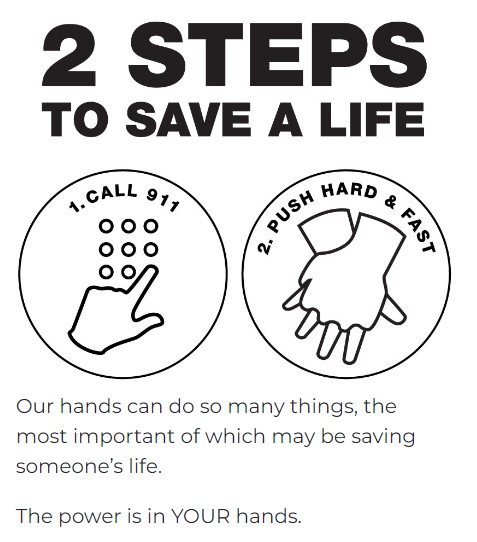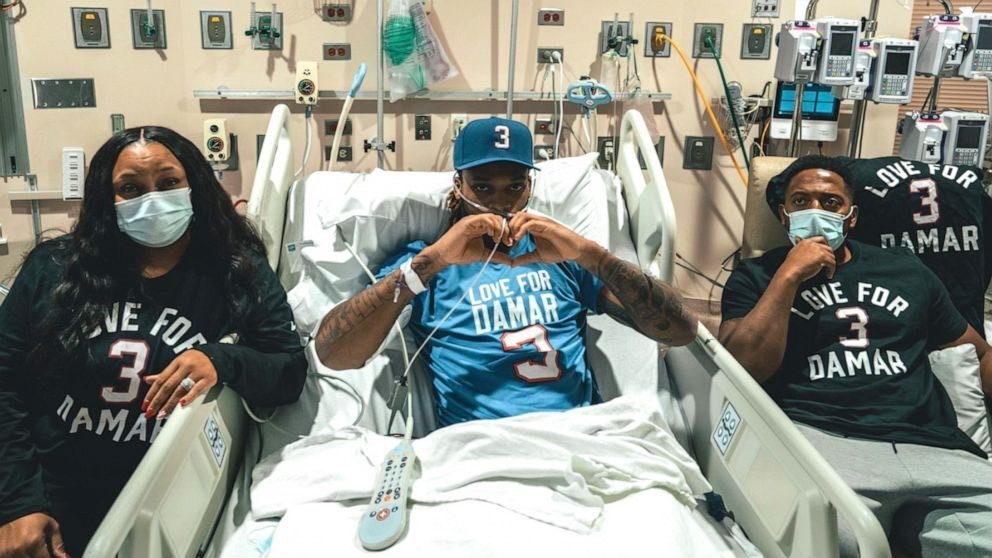As you followed the story of Damar Hamlin’s heart stopping during an NFL game, the questions surely ran through your mind.
What if I saw someone in cardiac arrest? Would I know what to do?
What if my heart stopped? Would anyone around me know what to do?
Hamlin himself wants to help provide the best answers.
In celebration of his life being saved by CPR, Hamlin is challenging everyone to take three quick, easy steps to turn more people into lifesavers.
Hamlin – who wears jersey No. 3 for the Buffalo Bills – is teaming with the American Heart Association on the #3forHeart CPR Challenge. The steps are:
- Learn Hands-Only CPR – which you can do by going to heart.org/3 and watching a 60-second video.
- Donate to the AHA to fund CPR education and training, other lifesaving programs and scientific research.
- Post on social media that you’ve taken the #3forHeart CPR Challenge and tag three friends, encouraging them to join the challenge.
February is a perfect time for this.
American Heart Month is always in February. This year, the AHA already was planning to spend the month spotlighting CPR, including our Be The Beat program that encourages every household to have at least one person trained in the lifesaving skill of CPR.
Then, on Jan. 2, Hamlin went into cardiac arrest in the most public of places: a Monday night game between two of the NFL’s top teams.
The response was straight from a textbook. He received immediate high-quality CPR from Bills assistant athletic trainer Denny Kellington and had his heart restarted by a defibrillator within minutes.
More than 350,000 people per year go into cardiac arrest outside of a hospital – that is, while going about their everyday lives. Fewer than 10% survive, mainly because so few people receive CPR and have access to an automated external defibrillator, or AED.
Here’s one more stat: Those who do receive immediate CPR are twice or even three times as likely to survive.
Why?
Cardiac arrest is an outage of the heart’s electrical system. With the power out, the person’s heart is no longer beating. That means it’s no longer pumping blood to the rest of their body. And that means their brain and other organs aren’t receiving oxygen. By giving them chest compressions, you are mimicking the beating of their heart, thus keeping their blood flowing. Using an AED can restore the power.
“CPR saved my life earlier this year on the field,” Hamlin said in a video posted on Instagram on Feb. 1. “And CPR could easily save your life or someone you love.”
The lifesaving sequence – what’s known as the chain of survival – begins with recognizing that an adult or teen isn’t breathing.
Step 1 is to call 911.
If you’re with other people, pick a certain person to do it. This is important because it avoids the risk of everybody thinking someone else will do it. So call out someone by name or, if you’re with strangers, be specific: “Hey, you in the Buffalo Bills hat – call 911!”
If you’re alone, dial 911 then turn on speakerphone so you can begin ….
Step 2: Hands-Only CPR.
As the name implies, Hands-Only requires using only your hands. No mouth-to-mouth breathing.
All it takes to do Hands-Only CPR is to push hard and fast on the center of a person’s chest.

How hard?
At least 2 inches deep. That’s obviously hard to measure. Just remember that it’s better to push too hard than too soft. Putting it bluntly, too hard might break ribs; too soft can be fatal. “That person is already technically dead, so you don’t have to be afraid of making the situation worse,” Dr. Jen Ashton said when we discussed the #3forHeart CPR Challenge on “Good Morning America.”
How fast?
The technical answer is at least 100 times per minute. The easy-to-remember answer is to pump along with the beat of a song with that kind of rhythm. Conveniently, many songs do, including many with apt titles, such as “Stayin’ Alive” by the Bee Gees. Check out the 58 options on our Don’t Drop The Beat playlist. Pick the one you’re most likely to remember in the heat of the moment. Every time you hear the song, reinforce that connection so you’ll be even more ready should the time come.
Watching a video, taking a training course or actually practicing on a manikin or at a Hands-Only CPR training kiosk found in many airports – yes, those steps will make you better prepared to save a life than simply reading this article.
Still, by reading this far, you’ve already learned enough to make a difference.
And that leads to another vital message: Be willing to act.
Take a moment now to imagine someone needing you to perform CPR, and envision yourself responding. Being blunt once more, your willingness to try really could be the difference between life and death.

Jaster Athletes / Jordon Rooney
Remember that stat about less than 10% of people surviving cardiac arrest outside of a hospital? Do the easy math and you realize that more than 90% of people die in that situation.
The good news is that means there’s plenty of room for improvement.
“Every day I’m amazed that my experiences could encourage so many others across the country and even across the world – encourage to pray, encourage to spread love and encourage to keep fighting no matter the circumstances,” Hamlin said last Thursday during the NFL Honors ceremony, standing in front of the Bills and Cincinnati Bengals training and medical staffs, along with his care team from the University of Cincinnati Medical Center.
“Sudden cardiac arrest was nothing I would’ve ever chosen to be a part of my story, but that’s because sometimes our own visions are too small even when we think we are seeing the bigger picture,” he said. “My vision was about playing in the NFL and being the best player that I could be, but God’s plan was to have a purpose greater than any game in this world. … I have a long journey ahead, a journey full of unknowns and a journey full of milestones, but it’s a lot easier to face your fears when you know your purpose.”



